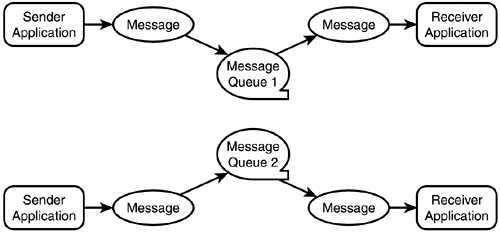Introduction to Messaging
| With the advent of distributed computing architecture in the computer world, dedicated servers performing distinct functions became inevitable. Along with this arose a need to communicate efficiently between these remote servers. To enable this, messaging concepts were introduced. As you might expect, messaging is a mechanism by which two software components or applications communicate with each other. This is done by maintaining a communicating agent that carries messages in different formats. This mechanism is analogous to a post office. The postal agent is the message carrier, and the letter being delivered is a message. The letter can be in the form of a parcel, a package, or even just an envelope. A receiver of mail is capable of sending mail too. You can send mail to a single person or to multiple people. You have the choice of getting confirmation when the mail you sent is received or just taking it for granted that the mail will reach its destination. A software messaging system, like the postal agent, carries message objects. Message objects can be in many formats, as you will discover later. The message can be sent from point to point, or it can be sent by a single source (the publisher) to multiple subscribers. On receipt of the message by the receiver, a confirmation may or may not be sent back to the source from which the message emanated. With the introduction of a messaging system to communicate between different software components, the next question that arises is, How is the difference in languages handled? To counter this problem, message-oriented middleware (MOM) servers were introduced. These middleware servers take care of the translation of messages between communicating servers. A message is a serializable object containing a header, properties, and a body. The header contains routing information, while the main message content is stored in the body of the message. Two types of message delivery are point-to-point and publisher-subscriber. Point-to-Point MessagingPoint-to-point messaging is also known as peer-to-peer messaging, P2P messaging, and PTP messaging. The message-sending component sends a message to a receiving component. Now the message can be directly sent to the receiving component or put onto a message carrier called a queue; see Figure 15.1. Figure 15.1. A point-to-point messaging system.
There can be only a single receiving component, although multiple senders can send messages through a single message queue. Publisher-Subscriber MessagingIn publisher-subscriber messaging, a sender (called a publisher) sends messages under a message carrier called a topic. Components that wish to receive this message (called subscribers) subscribe to this topic and receive the message (see Figure 15.2). This kind of a messaging system is used when the same message is to be received by multiple applications. The publisher needs to send only a single copy of the message. The messaging system has the responsibility of making a copy for each subscriber. Figure 15.2. A publisher-subscriber messaging system.
Here, there is no limit on the number of senders or the number of receivers. The action of removing the message from the queue or topic is called message consumption. There are two types of message consumption:
|
EAN: 2147483647
Pages: 339

